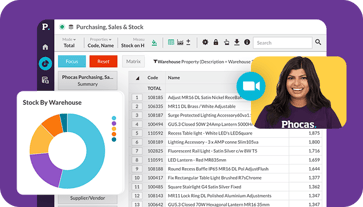The future of wholesale distribution is in your data
The distribution of goods is a vital part of the global economy. Nonetheless, as wholesale markets continue to be disrupted, it’s more difficult for distributors to remain competitive. However, data is a great equalizer. Wholesale distributors must take advantage of the wealth of information being generated by their companies each day, and turn it into actionable insights.
Building a data driven culture
Phocas has considerable experience helping wholesale distribution companies better understand their data. We have used this experience to develop a three-step process to ensure that our customers can build a strong data-driven business strategy.
Step 1: Identify your data sources: The first step is to identify the data you want to analyze. For instance, you may want the ability to analyze your ERP, financial, and purchasing data. If so, you will need the ability to combine disparate data into a single source. This way you will have a 360-degree view of your company.
Step 2: Measure, predict and optimize the outcomes from your data: With today’s technology, data is accessible to everyone. At Phocas, we recommend selecting a vendor that offers intuitive, easy-to-use, industry-specific analytics software. This includes customizable dashboards and pre-built alerts developed with the standard KPIs distributors need to measure and optimize your data.
Step 3. Adapt your business to do what the data analysis recommends: Finally, you must develop a data-driven company culture. If your management team leads by example, your employees will see that data insights lead to better decision-making. As users mine insights from your data, they will quickly develop a common language leading to a data-driven culture.
New ways to review metrics
In light of fierce competition, it is essential that wholesale distributors have visibility throughout their entire business. At Phocas, we’ve identified many important distribution metrics which come with the software. Below is one of these metrics that helps determine customer profitability.
Customer profitability Low-profit customers can come at a high cost, so it’s critical to have an accurate assessment of your customers to minimize at-risk relationships. A customer profitability analysis uses your customer purchasing data to determine their profitability.
At Phocas, we have pinpointed specific elements that affect profitability such as sales volume and cost-to-serve and developed a means to weigh these variables so companies can rank customers by their level of profitability. The following are the KPIs of cost to serve:
- Order sizes and frequency of orders: This metric impacts your inventory and handling costs. Frequent small orders incur higher sales administration costs than less frequent and larger orders.
- Accounts receivable: The cost to extend credit to a customer is determined by your own capital sources. A customer’s payment history is key to extending credit and payment history.
- The rate of returns and exchanges: Customers that frequently return or exchange items cost more due to additional handling and restocking expenses.
- Sales administration: This is the cost of sales and service calls. Customers that require multiple sales visits, or place multiple orders, cost more than customers that place orders in a single batch.
- Shipping or delivery: Customers that place multiple orders or require same-day delivery increase your delivery costs.
The changing needs of customers
Smartphones have changed the way we communicate and do business. Instead of calling, we text. And instead of using a computer, many companies manage their businesses from their phones and tablets. According to research from Google, mobile technology drives or an average of more than 40 percent of revenue, especially in industries such as distribution that depend more on sales than marketing to drive revenue.
Some of Phocas’ distribution customers now offer self-service portals so their customers can make mobile purchases and directly monitor their accounts. This channel has become a preferred method for re-ordering. Now sales reps only visit when they have a new product or a change in service. Providing customers with mobile accessibility from any device can give distributors the edge over their competition.
At Phocas, we’ve worked with distributors for nearly 20 years. Phocas makes it simple for users, regardless of skill level, to review metrics and find actionable insights and determine the best course of action for your customers and your company. With Phocas, your data becomes the common language of your business.
To read more about the many facets of data analytics in wholesale distribution download the eBook, Data-driven inventory optimization.


Empowering businesses with intuitive data analytics, driving informed decisions for growth and profitability. We make people feel good about data.
Related blog posts

Manufacturers, distributors and retailers rely heavily on their suppliers to deliver quality products on time and at the right price. Strong supplier relationship management (SRM) is essential for these industries because it enables you and your suppliers to map out the supply chain, achieve economies of scale and offer customers an extensive choice of products.
Read more
DIFOT (Delivered In-Full, On-Time) or OTIF (On-Time In-Full) is a fundamental KPI when analyzing the performance of your supply chain. The main goal is to get your customers the products they need, when they need them, in the quantity they ordered. DIFOT measures how successful your business is at achieving this objective and identifies procurement problems and supplier reliability.
Read more
Customer segmentation has been around for decades, but in many organizations, it’s still underutilized. Done right, it’s one of the most powerful tools to help sales teams focus their time and energy, optimize resources and improve the customer experience.
Read more
Picture a football coach preparing for the big game. He watches game‑tape, studying player metrics, analyzing every play and using real‑time stats to inform strategy. That’s exactly how sales managers and sales leaders should approach their coaching program—with a data‑driven approach.
Read moreBrowse by category

Find out how our platform gives you the visibility you need to get more done.
Get your demo today